So, I was going to blog about making my own bias tape. I guess I never did. It was easier than I thought, but I didn't take any pictures. You get more than 5' from one fat quarter. Probably like way more, I don't remember how much. Here it is.
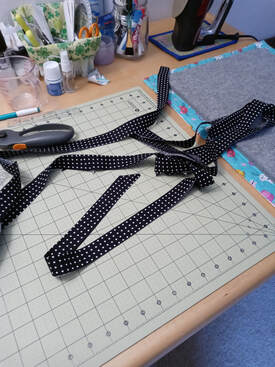 ALL HAIL THE VERY USEFUL BIAS TAPE
ALL HAIL THE VERY USEFUL BIAS TAPE I had no plans about how I was going to use it. I just made it. Because I could. What was I going to make that needed black with white polka dot bias tape? Who knows? It just needed to exist.
So, some time goes by and I'm experimenting with making a liner for my "banneton" (aka Dollar Store colander) because just laying a towel in there and flouring it works but it's hard to make sure the towel's not flippity flapping around too much. But, all the patterns I was seeing were highly complicated trapezoids with an added rectangle piece and then you have to calculate the right size circle for the bottom--woooooo boy, too much work for me.
I figured if I could get a circle of fabric with a wide enough circumference and put a channel in to run some elastic to keep it taut around the rim of the colander, it would just settle in the well of the colander and just kind of be OK until I put the bread in to rise.
I wanted things to be as simple as possible. I got so caught up in the process I didn't take pictures. Naughty me.
So, some time goes by and I'm experimenting with making a liner for my "banneton" (aka Dollar Store colander) because just laying a towel in there and flouring it works but it's hard to make sure the towel's not flippity flapping around too much. But, all the patterns I was seeing were highly complicated trapezoids with an added rectangle piece and then you have to calculate the right size circle for the bottom--woooooo boy, too much work for me.
I figured if I could get a circle of fabric with a wide enough circumference and put a channel in to run some elastic to keep it taut around the rim of the colander, it would just settle in the well of the colander and just kind of be OK until I put the bread in to rise.
I wanted things to be as simple as possible. I got so caught up in the process I didn't take pictures. Naughty me.
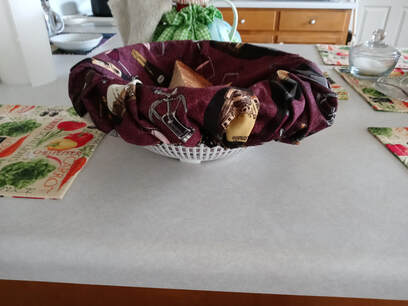 TOO BAD YOU CAN'T SEE THE BIAS TAPE
TOO BAD YOU CAN'T SEE THE BIAS TAPE The first one I made, I made just about an inch bigger around than the top of the colander. Not ~~~quite~~~ enough. The next one I did maybe a little too big, but, hey, better too big than too little, and maybe it will have other uses as well. I used the bias tape to make the channel to put the elastic through to draw it up. And I saved the first one, it fits pretty well in one of my Corningware bowls that I sometimes use to serve rolls or bread slices in, so that works out well.
The reason I'm making this all about the bias tape was how easy it was to apply it around the circumference of the circle. I was not looking forward to sewing it on, or sewing it up on the back to finish the channel. But it turns out my fears were unfounded.
The reason I'm making this all about the bias tape was how easy it was to apply it around the circumference of the circle. I was not looking forward to sewing it on, or sewing it up on the back to finish the channel. But it turns out my fears were unfounded.
As it turned out, homemade bias tape is much easier to work with (in my opinion so far anyway) than commercially produced bias tape. The stuff I get at the store is so stiff and hard to work with it makes me cringe just thinking about it. My homemade stuff was soft and pliable and worked out really well.
Despite loving the homemade stuff, I probably won't use it all the time, because it is a somewhat complicated process to make the stuff. It's not really that hard, just a bunch of steps that you must make sure and get right the first time, no exceptions. But if you pay attention, you have a good final product.
And, as The Critical Drinker says, "Anyway, that's all I've got for today" but I'm not going to tell you to "go away." LOL
Have a great one!!! Ciao for now!
Despite loving the homemade stuff, I probably won't use it all the time, because it is a somewhat complicated process to make the stuff. It's not really that hard, just a bunch of steps that you must make sure and get right the first time, no exceptions. But if you pay attention, you have a good final product.
And, as The Critical Drinker says, "Anyway, that's all I've got for today" but I'm not going to tell you to "go away." LOL
Have a great one!!! Ciao for now!
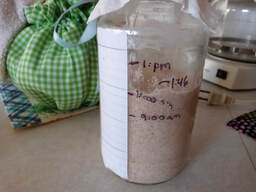
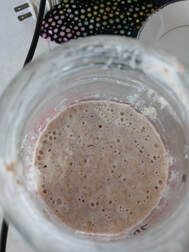
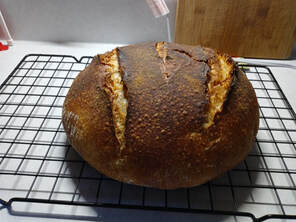
 RSS Feed
RSS Feed